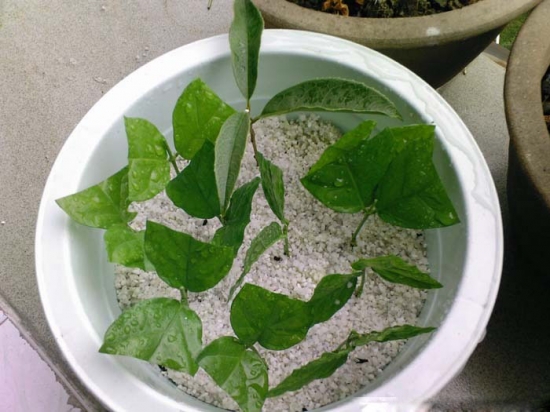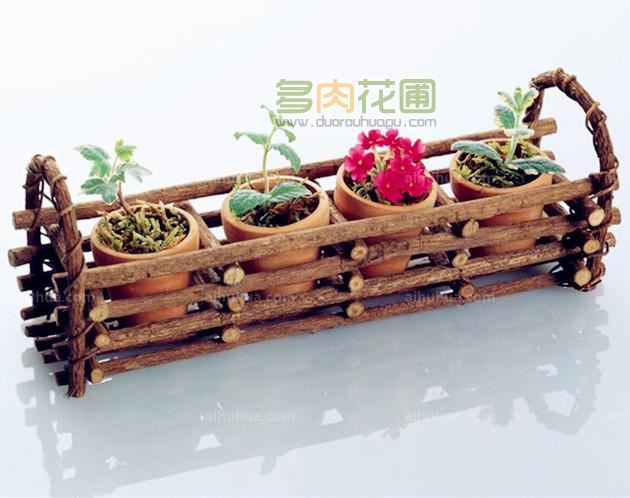How to manage flowers after cutting?
The main environmental factors affecting the survival of cuttings are temperature, humidity, light, aeration conditions and cutting substrate, and whether the management after cutting is proper or not directly affects the survival rate of cuttings.
① temperature has a great influence on the rooting of cuttings. Different kinds of flowers require different cutting temperatures. Generally, the rooting temperature of cuttings is 2 / 3 ℃ higher than that needed for cultivation. Cuttings are easier to root at 15: 20 ℃, and all greenhouse flowers that like high temperature take root at 25 ℃ ~ 30 ℃. If the soil temperature is 3-6 ℃ higher than the air temperature, it can promote the rapid occurrence of cuttings.
After ② humidity cutting, attention should be paid to keeping the cutter moist so as to create moist and aerated soil moisture. When cutting soft wood, in order to maintain a high relative humidity in the air, it is best to keep the relative humidity at 80%-90%, to prevent cuttings and retained leaves from wilting, and to rely on some green branches and leaves to produce nutrients for rooting. Therefore, to often spray into the insert bed, and cover with plastic film for moisturizing, in order to reduce the moisture evaporation of the cuttings. Before the formation of callus, appropriate more watering, and then gradually less watering.
The length and intensity of ③ sunlight have a great influence on the rooting ability of cuttings, and the rooting ability of long sunshine is stronger than that of 13 sunlight. It is better for cuttings to accept scattered light, and strong sunlight is harmful to the survival of cuttings. Too high temperature and large evaporation will lead to cuttings withering. Therefore, the cuttings should be given moderate shade at the initial stage to maintain a light transmittance of about 50%, but not on cloudy days. When the roots come out, they are gradually given plenty of sunlight.
When ④ ventilated cuttings take root, cell division is exuberant, respiration is enhanced, sufficient oxygen is needed, soil with good ventilation is selected, and appropriate amount of water is sprayed. When the temperature is high at noon, part of the film can be opened for ventilation, which is conducive to rapid rooting growth.
⑤ cutting medium was used for hardwood cutting in open field, which could be carried out in fertile sandy loam soil with high water content. Softwood cutting can be carried out in water, plain sand, vermiculite and perlite, slag and peat. The cutting substrate should be loose and have good aeration conditions, free of organic fertilizers and other moldy impurities, and can maintain a certain degree of humidity. The root system of cuttings should be transplanted as soon as possible, otherwise the cuttings leaves will become yellow and old due to insufficient supply of matrix nutrients, which will affect the growth and development of cuttings in the future.
Management methods after cutting of Flowers
First, temperature. Soft branch cuttings are generally suitable for cutting at 20 ℃-25 ℃, while plants that like high temperature take root more quickly at more than 25 ℃. For the flowers and trees which are difficult to root, if the ground temperature is 20 ℃-40 ℃ higher than the air temperature, it can promote rooting.
Second, humidity and moisture. Soft wood cutting requires high environmental humidity, which needs to be kept above 80%, so it is necessary to spray into the bed frequently, and plastic film is often used to build arch shed for moisturizing. Usually watering can be more appropriate before the formation of callus, and it should be reduced later.
Third, light. A certain amount of light can promote the rooting of tender wood cuttings with leaves. However, the sun is strong in the growing season, so it is necessary to shade and maintain a light transmittance of about 50%. Cloudy days can not be covered, after taking root, you should gradually remove the shade.
Fourth, air. Cuttings will suffocate and rot because the substrate is too wet and there is not enough air in the substrate. Therefore, the selection of matrix to be loose, good drainage, and to spray the right amount of water, when the temperature is high at noon, to open part of the film for ventilation.
After the cuttings take root, they should be transplanted as soon as possible, otherwise the leaves of cuttings will become yellow and old due to the lack of nutrients in the substrate, which will affect the growth and development in the future.
Techniques and methods of cutting Flowers in Water
Ordinary canned bottles are generally used for water containers. The bottle mouth uses a foam plug with a hole to secure the cuttings.
In the growing season, take the sturdy branches of the current year or biennial, about 3 nodes, keep 2-4 leaves in the upper part of the branch, cut the lower end obliquely into a horseshoe shape, and then insert it into a container containing water. The depth is 1 ℃ 2-2 ℃, and the water temperature should be kept at 20 ppm-25 ppm. Change the water twice a week. Usually put the container in a place with bright scattered light, sooner or later can receive light, but to avoid too strong light.
When the new root grows to about 3 cm, it can be transplanted into the basin. At the beginning of a period of time to maintain a high humidity, let it have an adaptation process, which is conducive to improve the survival rate of transplantation. Suitable for cutting in the water, such as gardenia, oleander, rubber tree, peach leaf coral, evergreen, tortoise back bamboo, hanging orchid, duck toe grass, ivy, four seasons begonia, primrose, fig, variable leaf wood, rose, Ruixiang, Michelia, dragon blood tree, mulberry, pomegranate, dahlia, dry umbrella grass, chrysanthemum, golden bract, colored leaf grass, marigold and so on.
How to manage after cuttage

Plants after cuttings
The main results are as follows: (1) temperature management temperature plays an important role in cuttings rooting. The suitable rooting temperature for soft wood cuttings of most flowers is 20 ℃ ~ 25 ℃, and for semi-hardwood and hardwood cuttings is 22 ℃ ~ 28 ℃. The optimum temperature for leaf and bud cuttings varies with different species, and the optimum temperature is in the range of 20-28. If the temperature of the cutting bed is lower than 20 ℃, it is not easy for the cuttings to take root, but if it is higher than 28, it is easy to wilt the cuttings leaves and affect the rooting. In spring, the external temperature is too low, if the cutter has a device to increase the bottom temperature, it is conducive to the survival of hardwood cuttings in early spring. Summer cuttings should pay attention to prevent the harm of high temperature, open the mulch and spray on the leaves to cool down.
(2) after water management cutting, the substrate is required to provide enough water to maintain the normal freshness of branches and leaves. Generally speaking, the soil water content of 50-60 is suitable, and too much water often leads to cuttings rot. At the same time, it is required to maintain a high air humidity, usually 80% ~ 90% relative humidity is better. For this reason, the foliar spray and the method of adjusting the cover should be used in time to control. In order to avoid sunlight exposure, cause a large amount of water transpiration and lead to leaf shrinkage, we should pay attention to shading.
(3) the terminal buds and leaves of cuttings under light management can carry out photosynthesis only in sunlight and produce auxins to promote rooting. However, because it has been isolated from the mother plant, it should be shaded properly, and the general degree of shading should be 70%. The cuttings can be moved out of the planting pot about half a month after rooting, first put in a hidden place to slow down the seedlings, wait for the root system to develop well and the plants are strong, and then gradually move to the place where there is plenty of sunshine and manage it according to the routine.
- Prev

How to propagate flowers by grafting?
Grafting is a method of propagating new plants by grafting a part of a plant onto another plant. The branches used for grafting are called scions, the buds used are called buds, the grafted plants are rootstocks, and the seedlings after grafting are grafted seedlings. When the scion germinates new branches and leaves, it indicates that the new individual is formed by cutting off the sprouting branches of the rootstock.
- Next

Maintenance methods of family potted flowers in spring
In spring, everything recovers and thrives. The plan of the year lies in spring, which is a good season for flower growth and breeding. for flower lovers, we should not only seize the opportunity to do a good job of flower breeding, but also do a good job of flower maintenance. 1. Timely breeding Spring is a good time for flower breeding
Related
- Fuxing push coffee new agricultural production and marketing class: lack of small-scale processing plants
- Jujube rice field leisure farm deep ploughing Yilan for five years to create a space for organic food and play
- Nongyu Farm-A trial of organic papaya for brave women with advanced technology
- Four points for attention in the prevention and control of diseases and insect pests of edible fungi
- How to add nutrient solution to Edible Fungi
- Is there any good way to control edible fungus mites?
- Open Inoculation Technology of Edible Fungi
- Is there any clever way to use fertilizer for edible fungus in winter?
- What agents are used to kill the pathogens of edible fungi in the mushroom shed?
- Rapid drying of Edible Fungi

